A newly released report from the California Air Resources Board (CARB) has sparked a renewed and intensifying debate in Sacramento regarding the state’s climate change policies. Despite California’s substantial strides in reducing greenhouse gas emissions, the report underscores significant challenges that remain in meeting the state’s climate goals. Among the most pressing issues are transportation-related emissions and addressing the environmental justice concerns faced by disadvantaged communities.
California has long prided itself as a leader in climate action, and over the years, the state has implemented a range of policies aimed at reducing carbon emissions and transitioning to a more sustainable future. These policies have helped to reduce emissions from various sectors, including power generation and industry. However, CARB’s latest findings reveal that transportation remains the largest source of greenhouse gas emissions in the state, making it a central focus for lawmakers and environmental advocates as they seek to curb the state’s carbon footprint.
Lawmakers from both political parties have called for more aggressive measures to accelerate California’s climate progress. One major proposal gaining traction is the expansion of incentives for electric vehicle (EV) adoption. Electric vehicles are seen as a key part of the solution to reducing transportation-related emissions. Legislators are calling for increased subsidies and tax breaks for consumers to make EVs more affordable and accessible, particularly in low-income communities that have been slow to adopt these vehicles due to their higher upfront costs.
In addition to expanding EV incentives, lawmakers are pushing for stricter emissions standards for industrial sectors, which have also been identified as significant contributors to California’s overall greenhouse gas emissions. Some have advocated for more stringent regulations to hold businesses accountable and push them to adopt cleaner technologies. Proponents argue that such measures are necessary if California is to meet its ambitious climate targets, including the goal of reducing emissions by 40% below 1990 levels by 2030.
Renewable energy investment also remains a central focus. California has made significant progress in expanding its clean energy infrastructure, but lawmakers and environmental groups believe that more needs to be done to scale up renewable energy sources like wind and solar power. This would not only help reduce emissions but also create jobs in green industries, a point that is gaining bipartisan support in Sacramento. Lawmakers are calling for increased funding and incentives to help further accelerate the state’s transition to a renewable energy economy.
Despite the broad support for further climate action, the debate in California is far from one-sided. Critics of the state’s climate policies have raised concerns that overly aggressive regulations could harm businesses and consumers, particularly in the context of a fragile post-pandemic economy. Some argue that the state’s ambitious climate goals, while laudable, may come at the expense of businesses struggling to cope with rising costs and regulatory burdens. The working class, too, may bear the brunt of these policies, with increased energy prices and higher costs for goods and services.
Environmental justice advocates have voiced similar concerns, but for different reasons. Communities that have historically been marginalized, often in areas with high pollution levels, are calling for more targeted action to ensure that climate policies do not disproportionately affect low-income and minority communities. These advocates argue that the transition to a greener economy must include measures to ensure equitable access to clean energy, job opportunities in renewable sectors, and affordable transportation options, especially for those who live in regions most impacted by climate change and pollution.
Governor Gavin Newsom, who has long been an outspoken proponent of climate action, is expected to back new legislation aimed at meeting the state’s 2030 emissions reduction goals. Newsom’s administration has already rolled out several initiatives in the past few years, including aggressive targets for clean energy and vehicle electrification. His support for the upcoming legislative proposals will be crucial, as it will signal the state’s continued commitment to ambitious climate goals while navigating the complex economic and social challenges that come with such policies.
The urgency of addressing climate change is underscored by the rapidly worsening effects of global warming, including increasingly frequent and severe wildfires, rising sea levels, and prolonged droughts. Environmental advocates are urging lawmakers to act quickly, warning that delays in implementing strong climate policies could lead to irreversible damage to the state’s ecosystems, economy, and public health in the coming decades.
As California enters the 2025 legislative session, the debate over climate change is expected to heat up further. With proposals on the horizon, including potential reforms to transportation policies and new investments in clean energy, the coming months will be critical in shaping the future of the state’s climate strategy. Legislators face the difficult task of balancing environmental goals with the economic and social realities faced by residents and businesses.



